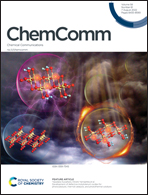EPR-based in situ enzymatic activity detection of endogenous caspase-3 in apoptosis cell lysates†
Abstract
Caspase-3 plays a vital role in cell apoptosis and related diseases. The detection and characterization of endogenous active caspase-3 are of immense value not only for mechanism studies of apoptosis but also for the diagnosis and treatment of apoptosis-related diseases. Here, an electron paramagnetic resonance (EPR)-based enzymatic assay was developed for the detection of caspase-3 activity both in vitro and in apoptosis cells. This assay uses a sandwich-like probe composed of a caspase-3-specific peptide segment (DEVD) conjugated to an EPR-detectable nitroxide spin label and magnetic beads (MBs). Cleavage of the “Nitroxide-Peptide-MBs” sandwich probe caspase-3 will release the nitroxide, which is readily detected by EPR after magnetic separation, resulting in a distinct EPR “off/on” transition. This assay takes advantage of the specific cleavage of DEVD-containing peptides by caspase-3 for high specificity, magnetic beads for fast magnetic separation, and EPR spectroscopy for considerably high detection sensitivity (LODs for caspase-3 are 116 nM at 60 min and 58 nM at 120 min). Importantly, the assay was proven to be compatible with complex biological samples and can detect the endogenous active caspase-3, thereby providing potential applications in the screening of protease-targeted drugs and the diagnosis of protease-associated diseases.



 Please wait while we load your content...
Please wait while we load your content...